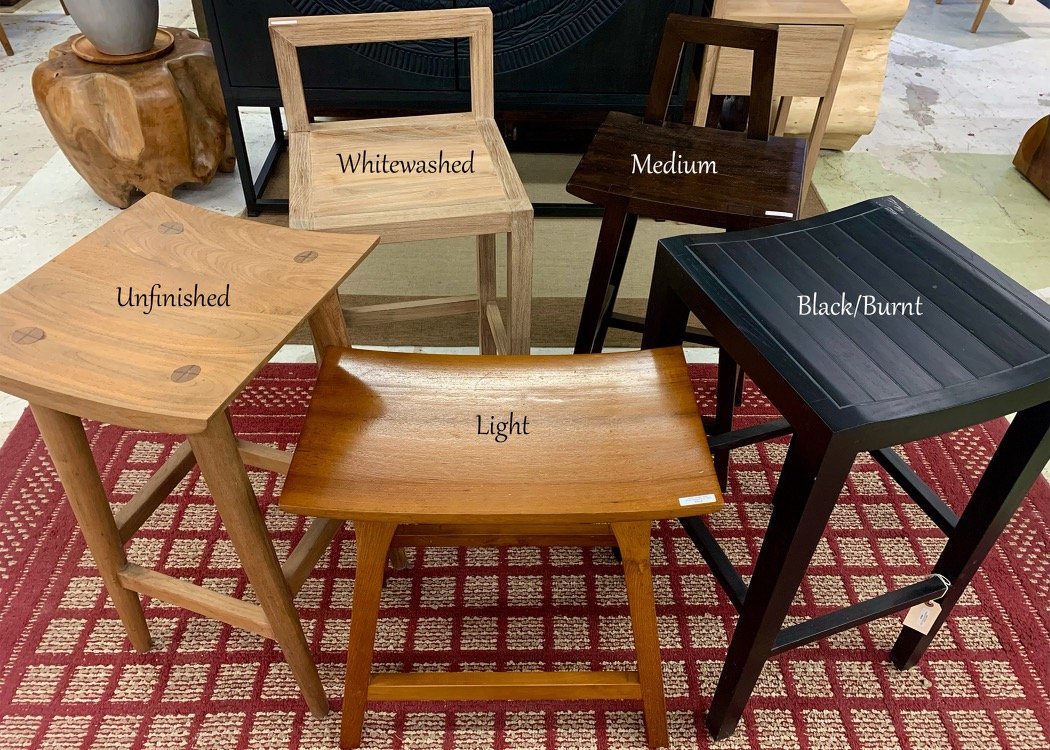Our Product
Our handmade teak furniture is handcrafted by the carpenters in our workshop in E. Java, Indonesia. Striving to be environmentally responsible, we use mostly salvaged materials from torn down houses, railroad ties, old furniture, as well as sustainably grown teak. Every piece of wood is hand selected for its natural elements. The grain, the burl, and the knots all become part of the overall design.
We design and make our own products, so we have the flexibility to remain contemporary and current in our design as well as offer custom furniture. By eliminating a middle mark up, we are able to provide our customers with high quality products at affordable prices. You will find that our handmade, solid wood furniture is lower in price than national chains such as West Elm, Crate & Barrel, Restoration Hardware, or Room & Board. With the closing of McKinnon Furniture and David Smith & Co., we are one of only a handful of stores in Seattle where you can purchase handcrafted wood furniture. Our inventory is constantly changing, as we receive a shipment of furniture every couple of months so come stop by!
Our Standard Stains
Medium Finish
Light Finish
Whitewashed
Unfinished
Black/Burnt
Clear Coat
Care Suggestions
As with all handcrafted solid wood furniture, the wood may shift and move a bit as it adjusts to it’s new environment. While most of the wood we use is reclaimed, and therefore already settled, we kiln dry any new pieces prior to construction. We recommend using a natural polish such as citrus oil and beeswax annually, or as needed on your furniture to keep the wood nourished. We typically use Howard Wood products, their Feed and Wax is great for keeping unfinished teak wood moisturized. Their Restore Finish is great for slight scratches or discoloration from heat. Some small cracking may occur over time, but shouldn’t compromise the structural integrity of the piece. To avoid scratches on tables with a finish, we recommend using placemats or felt pads on the base of rough items that you set on top.
Our Materials
Since our family has been in the furniture making business for decades, we are fortunate that our work is known in the region and so people come to our workshop when they have salvaged materials such as barns, wood bridges, torn down buildings, old benches, and large trees that have been removed for new road construction. We appreciate the opportunity to provide a new life for this wood.
Teak is a genus of tropical hardwood tree native to the south and southeast of Asia. They are large trees, growing to 90 to 120 feet high. The name teak comes from the Malayalam word Thekku. Teak is easily worked and has natural oils that make it suitable for use in exposed locations, where it is durable even when not treated with oil or varnish. Teak cut from old trees grown slowly in natural forests (Grade A), is more durable and harder; teak from young trees grown in plantations (Grades B through D), is more prone to splitting and water damage, however kiln drying allows for sustainable, plantation-grown teak to perform nearly on par with old-growth teak. Tirto Furniture uses only reclaimed or salvaged teak for our furniture.
Rosewood refers to a number of richly hued timbers, brownish with darker veining. All rosewoods are strong and heavy, taking an excellent polish, suitable for flooring, furniture, and musical instruments. Some species become canopy trees (to 30 meters high). The Forest Stewardship Council offers certification of sustain-ably harvested rosewood products as well. Tirto Furniture uses a rosewood known as Indian rosewood or sonokeling.
Our Construction
Mortise and Tenon: Simple and strong, the mortise and tenon joint has been used for a millennium by woodworkers around the world to join two pieces of wood, most often at an angle close to 90°. Although there are many variations on the theme, the basic idea is that the end of one of the members is inserted into a hole cut in the other member. The end of the first member is called the tenon, and it is usually narrowed with respect to the rest of the piece. The hole in the second member is called the mortise. The joint may be glued, pinned, or wedged to lock it in place. In China, the joints were traditionally made to fit together without the use of glue, and allowed for the natural expansion and contraction of wood in different temperatures. Owing to a long-standing Chinese influence, this principle can be found in many Indonesian structures as well.
Patches: Most of our teak and rosewood pieces have a variety of “patches” which come in different shapes and sizes. These are a mark of our craftspeople's ingenuity and a part of the unique character and individuality of our furniture. Each table, chair, stool, or cabinet we make is constructed by hand predominately from reclaimed materials. Usually these materials will have some wear and tear associated due to their "first life" use in other, non-furniture applications (floorboards, rafters, warehouse beams, telephone poles, railroad ties, etc.). As a way to achieve smoothness and consistency of texture without sacrificing large portions of usable wood, our carpenters cut out the area around nail holes, divots, hollow knots, and other structural imperfections and replace them with expertly cut patches that can be planed and sanded along with the rest of the board. This process is an integral part of Javanese furniture making culture, minimizing waste, and is of crucial importance in our policy of using sustainable materials.
Indonesian Culture
Tirto Furniture's workshop is located in Blitar, East Java, Indonesia, a city of approximately 1.1 million people, and the final resting place of Indonesia’s first president, Sukarno. Java is an island of Indonesia and the site of its capital city, Jakarta. Once the center of powerful Hindu kingdoms and the core of the colonial Dutch East Indies, Java now plays a dominant role in the economic and political life of Indonesia. Housing a population of 124 million, it is the most populous island in the world. It has three main languages, and most residents are bilingual, with Indonesian as their second language.
In the course of history, several kingdoms and colonies have existed on Java. This multi-cultural background of influences has intertwined itself into traditional Javanese society, and brought with it many traditions that have been adopted into local custom and trade. Javanese furniture makers draw from a diverse palette of furniture-making disciplines; Chinese, Indian, Dutch and British Colonial, that are combined with indigenous styles and techniques to create unique and intriguing hybrids imbued with a colorful whimsy and solid practicality.


